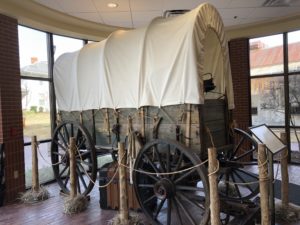 Are you looking for a Sunday family outing? Start with a Texas history appetizer at Frisco Heritage Museum and finish with family dining at Babes Chicken Dinner House.
Are you looking for a Sunday family outing? Start with a Texas history appetizer at Frisco Heritage Museum and finish with family dining at Babes Chicken Dinner House.
Frisco Heritage Museum
A covered wagon complete with prairie sound effects, a wall mural depicting historic cattle drives, and a section on king cotton are a few of the museum exhibits that walk us through North Texas history. On the second floor a frontier-styled house allow children to play and try their hand at pioneer chores. The museum shares its space with the Museum of the American Railroad who has a railroad section, while small, that provides a glimpse into train travel of yesteryear.
Third Sunday
The Frisco Heritage Center, located behind the museum, offers a collection of structures with their own story to tell. Normally, the buildings are closed, but on the third Sunday of each month, Frisco Heritage Center is open, free to the public. The afternoon includes events in the center’s vintage outbuildings. The North Texas Blacksmiths Association man Gabby’s Blacksmith conducting demonstrations throughout the afternoon.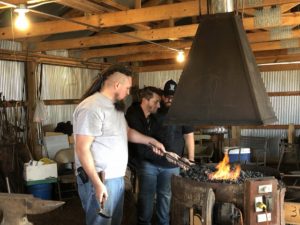 See smiths use forge and anvil to create nails and other objects, a crowd favorite with young scouts visiting the day of my visit. The Crozier-Sickles house, built in 1895, retains fixtures and furniture from the Crozier family. The old icebox in the kitchen and the hand-crank telephone contrast starkly to today’s refrigerators and smart phones. Other buildings include Lebanon Baptist Church (first built in 1883), a train depot, and a one-room schoolhouse replica.
See smiths use forge and anvil to create nails and other objects, a crowd favorite with young scouts visiting the day of my visit. The Crozier-Sickles house, built in 1895, retains fixtures and furniture from the Crozier family. The old icebox in the kitchen and the hand-crank telephone contrast starkly to today’s refrigerators and smart phones. Other buildings include Lebanon Baptist Church (first built in 1883), a train depot, and a one-room schoolhouse replica.
Railways Replace Cattle Trails
In addition to gaining an appreciation of life and lifestyles of long ago, the museum and heritage center offers a look at the effects of progress. A perfect example is the fate of frontier town Lebanon, now just a footnote in Texas history books. At the turn of the twentieth century, railways replaced cattle trails as the center for local commerce. On the old Chisholm Trail, Lebanon found itself a little over four miles from the new railway. Today, that seems a short distance but, back in 1902, it was far enough for folks to leave Lebanon and create Emerson, a new town closer to the railroad. A few years later Emerson would be renamed Frisco in honor of the company, St. Louis – San Francisco Rail Line, that precipitated the city’s birth. In February, the Frisco Heritage Museum will open a temporary exhibit on forgotten towns such as Lebanon.
Babes Chicken Dinner House
When you’ve had your fill of Frisco history, step next door to locally famous Babes Chicken Dinner House. It’s setting, down-home country, is the perfect place to end the afternoon. Babes offers good ol’ comfort food like country fried steak and chicken, with sides served family style.
When you go
Frisco Heritage Museum (6455 Page Street, Frisco) is open Wednesday through Saturday from 10 am to 5 pm, and on Sunday from 1 to 5 pm. Admission is $8 for a family, adults $4, and children just $2. The best time to visit the museum is on the third Sunday of each month with free access to the Heritage Center.
Babes Chicken Dinner House (6475 Page Street) is open seven days a week for lunch and dinner. A children’s menu is available.
Fun Fact: Did you know that a bale of cotton weighs five hundred pounds? Frisco’s last cotton gin closed in 1976.

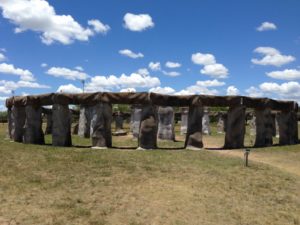 There you’ll find a Stonehenge and two Easter Island Moai head replicas. The structures are the work of two Hill Country residents, Al Shepperd and Doug Hill.
There you’ll find a Stonehenge and two Easter Island Moai head replicas. The structures are the work of two Hill Country residents, Al Shepperd and Doug Hill.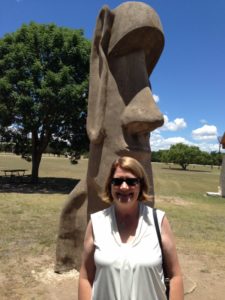 It’s a bucolic spot, with the Guadalupe River just off to the left.
It’s a bucolic spot, with the Guadalupe River just off to the left.
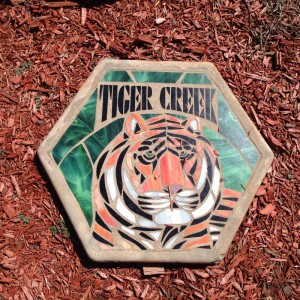 refuge spans 150 acres and houses over 40 big cats from tiger to bobcat. Several of the cats were victims of the exotic pet trade of the 1990s. Some cats were relocated when other refuges closed. And many of the cats have physical problems, like Babs. A bobcat, Babs is blind, most probably due to poor nutrition when he was kept as a pet.
refuge spans 150 acres and houses over 40 big cats from tiger to bobcat. Several of the cats were victims of the exotic pet trade of the 1990s. Some cats were relocated when other refuges closed. And many of the cats have physical problems, like Babs. A bobcat, Babs is blind, most probably due to poor nutrition when he was kept as a pet.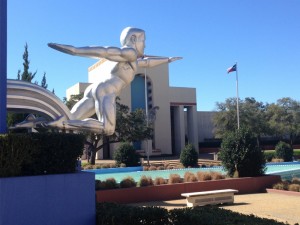 Fair Park is one of Dallas’ most beautiful locations and also one of its most overlooked. If you are like most Dallas residents, you visit Fair Park only once a year during the Texas State Fair. Yet this 227-acre park is open year round. On a sunny day, I find the art and architectural at Fair Park simply breathtaking.
Fair Park is one of Dallas’ most beautiful locations and also one of its most overlooked. If you are like most Dallas residents, you visit Fair Park only once a year during the Texas State Fair. Yet this 227-acre park is open year round. On a sunny day, I find the art and architectural at Fair Park simply breathtaking.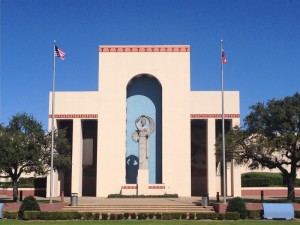 porticos at the Automobile Building and Centennial Hall frame six statues. Each statue represents a nation who, at one time, controlled Texas. Designed by Carlo Ciampaglia (Centennial Hall) and Pierre Bourdelle (Automobile Building), the statues bear the classical look of Greek goddesses.
porticos at the Automobile Building and Centennial Hall frame six statues. Each statue represents a nation who, at one time, controlled Texas. Designed by Carlo Ciampaglia (Centennial Hall) and Pierre Bourdelle (Automobile Building), the statues bear the classical look of Greek goddesses. 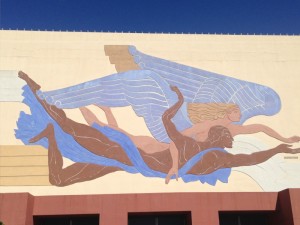 Reliefs on Centennial Hall continue the mythological theme and mix seamlessly with the modernistic murals of industry at the Automobile Building. Recently recreated fountain statues of The Tenor and The Contralto, add another exciting note to the whole Art Deco immersion.
Reliefs on Centennial Hall continue the mythological theme and mix seamlessly with the modernistic murals of industry at the Automobile Building. Recently recreated fountain statues of The Tenor and The Contralto, add another exciting note to the whole Art Deco immersion.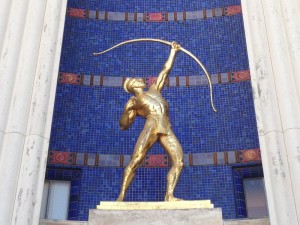 The
The 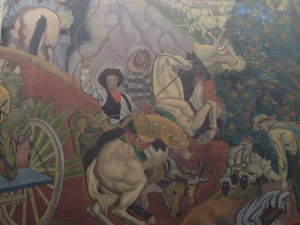 The murals cover every aspect of Texas history from the 1500 arrival of Europeans to images of higher education and state industries. On the floor, you’ll find mosaics of Texas animals, like the jackrabbit and horned lizard. Even the ceiling in the Great Hall is chocked full of symbolism – designed by George Davidson to represent Aztec motifs of roadrunner, armadillo, and rattlesnake. You can simply spend hours finding new tidbits of history and symbolism throughout the room.
The murals cover every aspect of Texas history from the 1500 arrival of Europeans to images of higher education and state industries. On the floor, you’ll find mosaics of Texas animals, like the jackrabbit and horned lizard. Even the ceiling in the Great Hall is chocked full of symbolism – designed by George Davidson to represent Aztec motifs of roadrunner, armadillo, and rattlesnake. You can simply spend hours finding new tidbits of history and symbolism throughout the room.